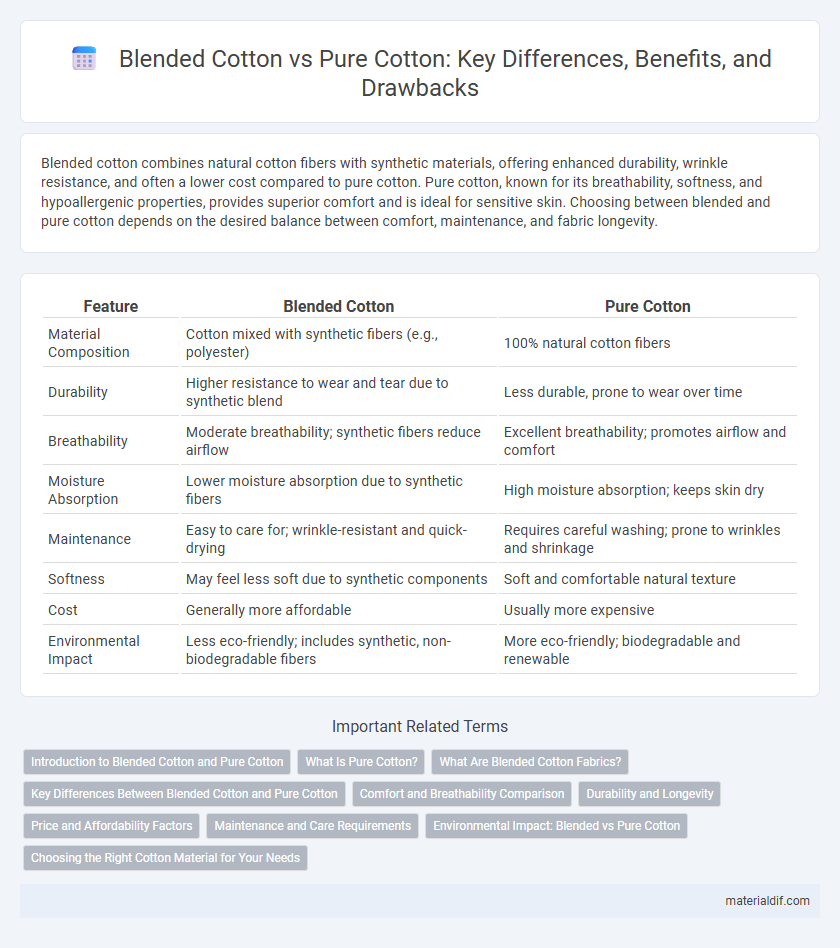Blended cotton combines natural cotton fibers with synthetic materials, offering enhanced durability, wrinkle resistance, and often a lower cost compared to pure cotton. Pure cotton, known for its breathability, softness, and hypoallergenic properties, provides superior comfort and is ideal for sensitive skin. Choosing between blended and pure cotton depends on the desired balance between comfort, maintenance, and fabric longevity.
Table of Comparison
| Feature | Blended Cotton | Pure Cotton |
|---|---|---|
| Material Composition | Cotton mixed with synthetic fibers (e.g., polyester) | 100% natural cotton fibers |
| Durability | Higher resistance to wear and tear due to synthetic blend | Less durable, prone to wear over time |
| Breathability | Moderate breathability; synthetic fibers reduce airflow | Excellent breathability; promotes airflow and comfort |
| Moisture Absorption | Lower moisture absorption due to synthetic fibers | High moisture absorption; keeps skin dry |
| Maintenance | Easy to care for; wrinkle-resistant and quick-drying | Requires careful washing; prone to wrinkles and shrinkage |
| Softness | May feel less soft due to synthetic components | Soft and comfortable natural texture |
| Cost | Generally more affordable | Usually more expensive |
| Environmental Impact | Less eco-friendly; includes synthetic, non-biodegradable fibers | More eco-friendly; biodegradable and renewable |
Introduction to Blended Cotton and Pure Cotton
Blended cotton combines natural cotton fibers with synthetic materials like polyester, enhancing durability, wrinkle resistance, and moisture-wicking properties compared to pure cotton. Pure cotton consists solely of natural cotton fibers, offering superior breathability, softness, and hypoallergenic qualities ideal for sensitive skin. The choice between blended and pure cotton depends on the desired balance of comfort, maintenance, and performance in textiles.
What Is Pure Cotton?
Pure cotton refers to fabric made entirely from natural cotton fibers without any synthetic blends, ensuring maximum breathability, softness, and hypoallergenic properties. It offers superior moisture absorption and durability compared to blended cotton, which mixes cotton with materials like polyester or nylon. Pure cotton is favored for its comfort, natural feel, and eco-friendly benefits, making it ideal for sensitive skin and sustainable fashion choices.
What Are Blended Cotton Fabrics?
Blended cotton fabrics combine natural cotton fibers with synthetic materials like polyester, enhancing durability, wrinkle resistance, and moisture-wicking properties compared to pure cotton. These blends offer improved strength and shape retention while maintaining the softness and breathability characteristic of cotton. Manufacturers often use blends to optimize fabric performance for various apparel and home textile applications.
Key Differences Between Blended Cotton and Pure Cotton
Blended cotton combines natural cotton fibers with synthetic materials like polyester, enhancing durability, wrinkle resistance, and moisture-wicking properties compared to pure cotton. Pure cotton consists of 100% natural fibers, offering superior breathability, softness, and hypoallergenic benefits but tends to wrinkle easily and shrink after washing. The choice between blended and pure cotton depends on desired fabric performance, care requirements, and comfort preferences.
Comfort and Breathability Comparison
Blended cotton fabrics combine natural cotton fibers with synthetic materials, enhancing durability and wrinkle resistance while slightly reducing breathability compared to pure cotton. Pure cotton, prized for its all-natural composition, excels in comfort and breathability, allowing superior air circulation and moisture absorption, which keeps the skin cool and dry. The choice between blended and pure cotton ultimately depends on the desired balance between comfort, breathability, and fabric longevity.
Durability and Longevity
Blended cotton fabrics combine cotton with synthetic fibers such as polyester, enhancing durability and resistance to wear and tear compared to pure cotton. Pure cotton offers breathability and softness but tends to wear out faster, showing signs of pilling and shrinking over time. The blend's improved strength and shape retention contribute to longer-lasting garments suitable for frequent use and washing.
Price and Affordability Factors
Blended cotton fabrics typically cost less than pure cotton due to the inclusion of synthetic fibers like polyester, which reduce production expenses and increase durability. Pure cotton offers superior breathability and softness but commands a higher price because of the natural fiber's cultivation and processing costs. Affordability of blended cotton makes it a popular choice for budget-conscious consumers while pure cotton remains preferred for premium, natural textile quality.
Maintenance and Care Requirements
Blended cotton fabrics generally require less maintenance compared to pure cotton due to their enhanced durability and wrinkle resistance, reducing the need for frequent ironing. Pure cotton demands careful washing with mild detergents and lower temperatures to prevent shrinkage and preserve softness. While blended cotton can tolerate machine drying, pure cotton is better air-dried to maintain fiber integrity and avoid damage.
Environmental Impact: Blended vs Pure Cotton
Blended cotton fabrics, combining natural cotton with synthetic fibers, often require less water and pesticides during cultivation but can be harder to recycle, increasing environmental waste. Pure cotton, though biodegradable and easier to recycle, typically demands higher water usage and pesticide application, leading to greater environmental strain. Selecting sustainable cotton sources like organic cotton reduces chemical impact regardless of blending, promoting eco-friendlier textile production.
Choosing the Right Cotton Material for Your Needs
Blended cotton combines natural cotton fibers with synthetic materials like polyester, offering enhanced durability, wrinkle resistance, and affordability compared to pure cotton. Pure cotton provides superior breathability, softness, and hypoallergenic properties, making it ideal for sensitive skin and high comfort requirements. Selecting between blended and pure cotton depends on factors like desired fabric longevity, ease of care, and tactile preference for specific uses such as apparel, bedding, or upholstery.
Blended Cotton vs Pure Cotton Infographic

 materialdif.com
materialdif.com